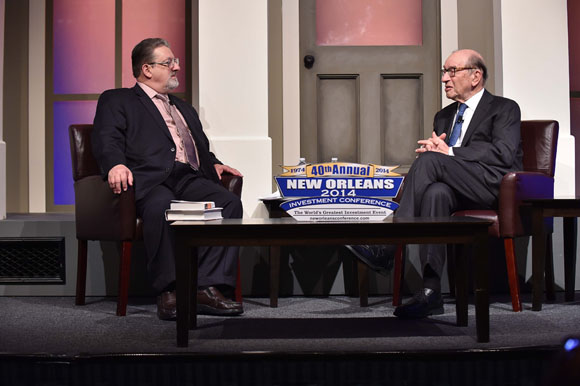When Dr. Alan Greenspan became chairman of the Federal Reserve, he moved from the world of rhetorical economics to the world of action. His most recent memoir, “The Map and the Territory 2.0: Risk, Human Nature, and the Future of Forecasting,” attempts to make sense of how the financial crisis of 2008 came to be and how we can better predict future crises, along with the role of gold in a global monetary system. In this excerpt from Greenspan’s appearance at the New Orleans Investment Conference with Navellier & Associates Senior Writer Gary Alexander, Gloom, Boom & Doom Report Publisher Marc Faber and Stansberry & Associates Investment Research Founder Porter Stansberry, The Gold Report delves into the role of gold versus fiat currency, why central banks own so much gold if it is truly “a barbarous relic,” and the reason China is buying so much gold today.

Gary Alexander:Â You said that when you were named to the position of Federal Reserve chair you left the world of theoretical economics philosophy and entered the arena of action. You moved beyond the role of pamphleteer on the sideline to being part of the action. In what way did your objectivist teaching from your time with Ayn Rand and your belief in the gold standard influence the people around you? How did you convince people to see things your way or did you feel that most of the compromise went the other way?
Alan Greenspan:Â When I wrote a paper on how agricultural subsidies made no sense to the farmers in the long run, two Republican senators from Nebraska taught me the reality of actually implementing the values we hold as best we can in the context of a political environment. I never changed my fundamental views because they were rational. President Ronald Reagan advised that other than your core beliefs, which are protected by the Constitution, sometimes you have to compromise. We learned to change the world bit by bit.
GA:Â When you took office in August of 1987, the gold price was $460 an ounce ($460/oz) on your first day. It peaked at $504/oz in December of 1987. Over the next 12 years, it was cut in half to $252/oz by August of 1999. Many believe that during that time, the Fed must have been selling gold or manipulating the market in some way to push the price of gold down. Was anything like that happening?
AG: No. Some central banks were major sellers of gold in that particular period. We were very concerned about that. If all the central banks sold gold at the same time, it really would have brought the price down. So they set up a partitioning scheme—some called it a cartel—where individual central banks were given quotas of what they could sell at certain times. The United States abstained from that group.
In my new book, I cover the role of gold and why the U.S doesn’t sell all of its gold. If it’s a barbarous relic, as some say, and it earns nothing and it costs money to store it, why are central banks holding so much of it?
GA:Â That’s a question I was going to ask you. Ron Paul asked Ben Bernanke in Congressional testimony that simple three-word question “Is gold money?,” which got a one-word answer, No. What do think?
AG:Â It’s currency, of course. Gold, and to a lesser extent silver, are the only major currencies that don’t require a third party credit guarantee. Gold is inbred in human nature. Gold is special. For more than two millennia, gold has had virtually unquestioned acceptance as payment to discharge an obligation. Remember, Germany could not import any goods in the last part of World War II unless it paid in gold.
Today, China is beginning to convert part of its $4 trillion ($4T) foreign exchange reserve into gold as a partial diversification out of the dollar. Irrespective of whether the yuan is convertible into gold, the status of the Chinese currency could take on unexpected strength in today’s fiat money, floating international financial system. It would be a gamble for China to try to buy enough gold bullion to displace the United States’ $328 billion of gold reserves as the world’s largest holder of monetary gold. But the cost of being wrong, in terms of lost interest and cost of storage, would be quite modest.
If China embarks on a gold accumulation program, global gold prices will rise, but only during the period of accumulation.
GA:Â One of your statements in your book is that even though the gold standard was not practical, you still believe in the theory of the gold standard.
AG:Â A return to the gold standard in any form is nowhere on anybody’s horizon.
GA:Â The Fed has now been around for a hundred years. Would the Fed be considered a successful manager of the value of the dollar over the last century?
AG:Â Remember, what the Fed does is what Congress requires of it. When the Fed started out, U.S. currency was still on the gold standard. It was set up largely in response to the panic of 1907 as the lender of last resort. The gold standard was abandoned in 1933 because it appeared to be depressing the general price level and inhibiting recovery out of the Great Depression. More important, the restrictive nature of gold undermined the fiscal flexibility required by the New Deal’s welfare state. Some blamed gold for the depression, but the problem wasn’t convertibility to gold, it was a problem with the people pricing it.

